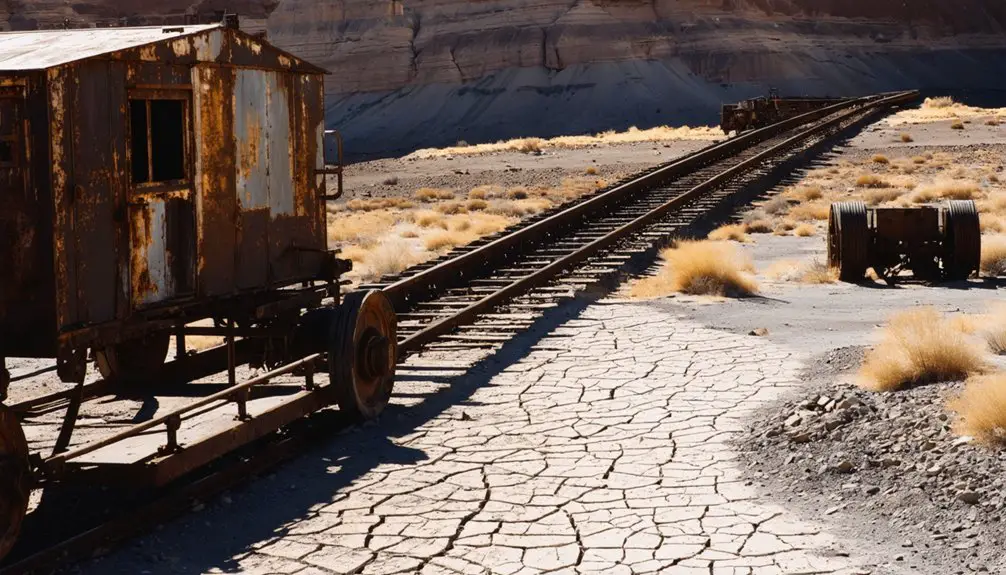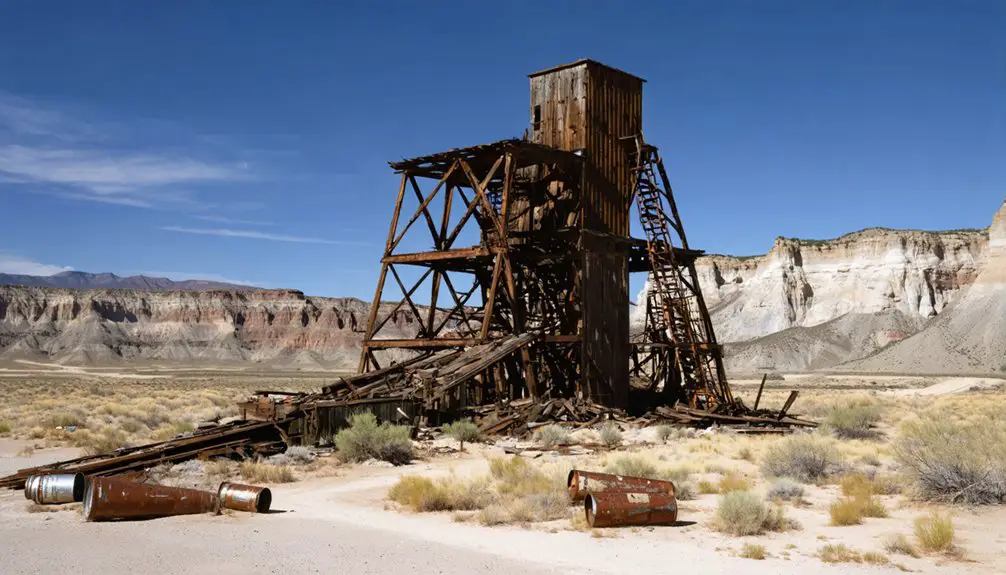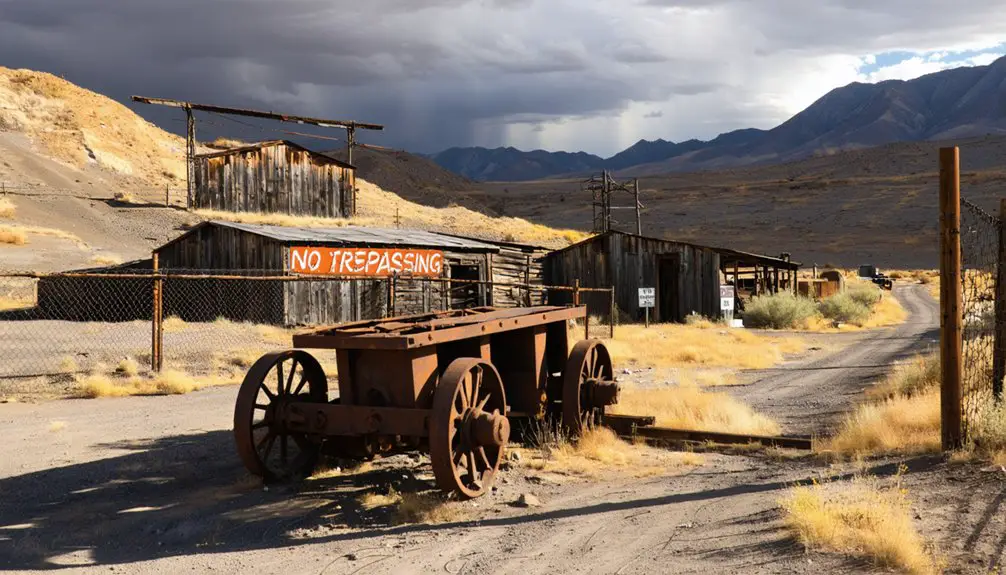You’ll find Tempiute ghost town in Lincoln County, Nevada, where silver was first discovered in 1868. The site transformed from a modest silver mining camp into a vital tungsten producer during World War II, housing up to 700 residents at its peak. Though water scarcity constantly challenged miners, the town persisted through several boom-and-bust cycles until its eventual decline. Today, scattered stone foundations and abandoned mining equipment tell the story of this resilient desert community.
Key Takeaways
- Tempiute was a Nevada mining town known first for silver (1868) and later tungsten (1916), now abandoned on private property.
- The town’s population peaked at 700 during World War II when tungsten mining operations were at their height.
- Water scarcity significantly impacted mining operations and daily life, requiring transportation from distant valleys for both residents and ore processing.
- Remnants include stone cabin foundations, abandoned mine shafts, ore chutes, and rusted mining equipment scattered throughout the site.
- The name “Tempiute” comes from Southern Paiute language meaning “rock water people,” reflecting the area’s rugged terrain and water resources.
The Silver Rush That Started It All
While precious metals drew fortune seekers across Nevada in the 1860s, silver’s discovery at Tempiute Mountain before 1868 sparked minimal interest until ranchers Service & Plumb made a significant find in December 1868. Their discovery led to the district’s reorganization as Tem Piute, marking the area’s first serious mining endeavor.
You’d have found impressive silver deposits here, with ore assays ranging from $72 to $300 per ton. Despite these promising numbers, development moved slowly due to limited water access and competition from White Pine’s silver rush. The camp’s development was particularly hindered as water had to be hauled from the distant valley.
By 1870, the district attracted fifty working miners who shipped their valuable ore to the processing facilities at Crescent City.
Origins of the Tempiute Name
When you examine the origins of Tempiute’s name, you’ll find its roots in the Southern Paiute language, where it means “rock water people.”
Early settlers adopted the name from the indigenous Paiute people who inhabited the region, though they recorded several variations including Tem-Pah-Ute, Tempahute, and Tem Piute. Modern visitors can learn more about the area’s indigenous history at the museum in Mesquite.
The name’s elements – rock and water – reflected both the area’s rugged terrain and the essential water resources that sustained the Paiute’s connection to this land. The area later gained significance when tungsten ore deposits were discovered on Tempiute Mountain in 1916.
Southern Paiute Language Connection
The name “Tempiute” originates from the Southern Paiute language, meaning “rock water people” and reflecting the indigenous connection to the region’s natural resources.
You’ll find several historical variants of this name, including Tem-Pah-Ute and Tempahute, all preserving the original linguistic heritage of the area’s first inhabitants.
The Southern Paiute traditionally lived in small band groups that maintained their independence while sharing linguistic and cultural ties.
The Southern Paiute, who call themselves Nuwuvi (“the people”), speak a language from the Numic branch of the Uto-Aztecan family.
Their traditional territory stretched across southern Nevada, Utah, northwestern Arizona, and southeastern California.
This linguistic influence remains visible today in numerous regional place names.
While distinct from Northern Paiute groups, Southern Paiute speakers maintained their cultural practices longer due to relatively peaceful relations with settlers, helping preserve their language’s imprint on the landscape.
Many Southern Paiute sustained their traditional ways by working on ranches while maintaining connections to their ancestral lands.
Early Settler Name Adoption
Since the initial silver discovery at Timpahute Mountain during the Pahranagat rush, the name “Tempiute” became firmly established in regional history.
Early settler interactions in December 1868 proved pivotal when ranchers Service & Plumb reorganized the mining district, formalizing the Tem Piute name.
The area’s name significance grew as miners extracted valuable ore grading from $72 to $300 per ton. The mining operations sustained a bustling community until the tungsten mine closed in 1988.
In 1970, the town was initially established as Tempiute Village before being renamed to Rachel.
Rock Water People Translation
Derived from Southern Paiute language, Tempiute’s name translates to “rock water people,” reflecting the indigenous population’s deep connection to the region’s natural features.
You’ll find this name captures the essence of Paiute heritage, symbolizing both the rocky landscape and precious water sources that sustained life in this harsh desert environment.
The name’s spelling evolved through various forms, including Tem-Pah-Ute and Tempahute, as English speakers attempted to transcribe Paiute pronunciations.
This environmental adaptation remains preserved in the name of Tempiute Mountain and surrounding geography.
When miners arrived in the 1870s, they adopted this indigenous name for their settlements, officially using it for the post office in 1879.
The name’s components perfectly encapsulate the relationship between the people and their challenging desert home.
Located in Lincoln County, Nevada, Tempiute’s rugged terrain exemplifies the characteristics that influenced its naming.
Archaeological evidence shows the Paiute presence through petroglyphs and arrowheads discovered throughout the surrounding hills.
Life in Early Tempiute Mining Camp
Life in Tempiute’s mining camp was defined by the constant struggle for water, which had to be hauled from the valley or piped in from twelve miles away.
You’d find miners living in basic cabins while dealing with harsh mountain conditions and limited access to supplies, which often came from peddlers traveling from southern Utah mining camps.
The camp’s population never exceeded 50 people during its peak silver mining period, as the water scarcity and remote location created significant barriers to growth and sustainability.
Daily Mining Camp Struggles
While Tempiute’s silver ore assays promised lucrative returns of $72 to $300 per ton, the mining camp’s daily reality proved far more challenging.
You’d face daily operational hurdles at every turn – hauling water 12 miles from the valley until a pipeline was built, traversing steep terrain to reach mining sites, and dealing with washout-prone roads that complicated supply deliveries.
The mining community dynamics reflected the harsh conditions, with only about 50 residents living in rudimentary cabins scattered across the landscape.
You’d struggle against the boom-and-bust cycles as mills closed and mining companies failed.
The physical toll of manual labor, combined with limited access to basic amenities and medical care, made survival in this remote outpost a constant test of determination.
Water Scarcity Shaped Life
As miners settled in Tempiute during the late 1870s, they immediately confronted the harsh reality of water scarcity that would define life in the camp.
You’d have found water transportation an endless challenge, with precious supplies hauled 12 miles from distant springs by pack animals and manual labor. The limited water access directly impacted mining sustainability, restricting the camp’s population to around 50 people.
The daily struggle for water shaped every aspect of camp life:
- Water had to be carefully rationed between drinking needs and ore processing
- A pipeline was eventually built to replace manual hauling, though it proved insufficient
- High costs of water transportation forced many operations to ship ore to external mills
These persistent water challenges ultimately contributed to Tempiute’s decline by the mid-1880s as miners sought better-supplied locations.
Challenges of Desert Mining Operations

Operating a mine in Nevada’s harsh desert environment presents numerous complex challenges that impact both profitability and sustainability.
Mining in Nevada’s rugged desert faces multiple operational hurdles, requiring careful balance between financial success and environmental stewardship.
You’ll face critical water management issues, as mining operations consume about 7% of Nevada’s total water use. When you extract groundwater, you risk depleting aquifers by up to 50 feet, threatening both local communities and fragile ecosystems.
The ecological impact of desert mining extends beyond water concerns. You’ll need to navigate strict regulations protecting endangered species like the Ash Meadows pupfish.
Your mining activities will generate dust and pollution that affect air and soil quality, while excavation permanently alters the landscape.
You’ll also contend with hazardous silica dust exposure, which puts workers at risk of serious lung diseases, complicated by limited access to emergency services in remote locations.
The Rise and Fall of Silver Production
The discovery of silver on Tempiute Mountain in 1865 marked the beginning of the area’s mining saga.
After ranchers Service & Plumb’s significant find in 1868, silver mining operations expanded rapidly, with ore values reaching up to $300 per ton.
By 1870, you’d find about 50 miners working the claims, sending their ore to nearby mills.
The economic impact of silver mining in Tempiute faced several key challenges:
- Limited water access forced expensive hauling from the valley
- Planned 20-stamp mill never materialized despite pipeline construction
- Competition from other districts strained resources
The boom was short-lived.
By the mid-1880s, silver production declined sharply, and the post office closed in 1883.
While intermittent mining continued until 1935, Tempiute’s silver era had effectively ended, giving way to later tungsten operations.
Tungsten Discovery and the Lincoln Mine

When prospectors discovered tungsten ore on Tempiute Mountain in 1916, they couldn’t have predicted its future significance to America’s war effort.
Though initial deposits were small, tungsten mining gained momentum in the 1930s with the construction of a local mill.
The real economic impact emerged when the Lincoln Mine Company developed the site in the 1940s, making it an essential tungsten source during World War II.
You’ll find a pattern of boom-and-bust cycles following the war years, as tungsten prices dictated the mine’s fate.
The Black Rock Mining Company consolidated operations in 1950, and later Union Carbide Corporation ran the mine from 1976 to 1987.
Today, the Lincoln Mine sits idle on private property, a reflection of Tempiute’s remarkable role in America’s industrial and military history.
World War II Mining Boom
During World War II, Tempiute transformed from a quiet mining district into a bustling strategic hub as America’s urgent need for tungsten sparked unprecedented growth.
The Lincoln Mine became one of the nation’s essential tungsten producers, while wartime demand drove rapid expansion throughout the district.
You’ll find the mining prosperity attracted hundreds of workers, with the population swelling to around 700 residents.
The Wah Chang Trading Company managed operations, and the community grew to include:
- A reopened post office serving the mining families
- New educational facilities for workers’ children
- Expanded milling operations and infrastructure
Modern Mining Attempts and Closures

You’ll find that modern mining attempts at Tempiute faced recurring economic cycles, with Union Carbon’s Minerals Division taking ownership of the New Tempiute Mine by 1992 to extract tungsten and other metals at 7,300 feet elevation.
While companies tried to overcome historic infrastructure challenges through improved water management and mechanized mining techniques, the persistent issues of water scarcity and transportation costs continued to impact operations.
Limited production records beyond the early 1990s suggest the New Tempiute Mine eventually succumbed to the same economic and logistical difficulties that plagued earlier mining ventures in the area.
Economic Cycles Impact Operations
After World War II sparked intense demand for tungsten, Tempiute experienced dramatic economic swings that shaped its mining operations throughout the latter half of the 20th century.
The town’s economic sustainability hinged entirely on tungsten’s market value, creating a cycle of booms and busts that determined mining profitability.
- 1957 marked a devastating downturn when plummeting tungsten prices forced operations to halt, leading to the mill’s dismantling.
- The 1970s brought renewed hope as Union Carbide reopened mining operations during a price surge.
- Further market volatility in the 1980s led UMETCO Minerals Corp. to struggle with maintaining viable production.
These economic cycles repeatedly transformed Tempiute from a bustling mining town of 700 residents to a near-deserted ghost town, demonstrating how market forces controlled the community’s destiny.
Infrastructure Challenges Persist
Modern attempts to revive Tempiute’s mining operations face significant infrastructure hurdles, despite the site’s existing facilities. While you’ll find usable ore loading facilities and mill buildings, they’ll need substantial infrastructure improvements to meet current mining regulations and operational demands.
You’re looking at multiple challenges: constructing new processing facilities, installing a 7.2 kV powerline, and upgrading nearly a mile of access roads.
The Bureau of Land Management’s environmental assessments must clear any development plans, and you’ll need a 30-year right-of-way for power lines and communication sites. Technical barriers include refurbishing old infrastructure while ensuring safety compliance.
Time pressures compound these challenges, as America’s tungsten supply chain heavily depends on imports. You’re racing against market demands while maneuvering through complex regulatory requirements.
Corporate Ownership Changes
Since its discovery in 1916, Tempiute’s Lincoln Mine has experienced numerous ownership changes driven by tungsten market fluctuations. The corporate shifts reflect the volatile nature of tungsten prices, with ownership dynamics shifting through several key phases:
- Lincoln Mine Company developed operations in the 1940s during WWII’s peak demand, but post-war price drops forced closure.
- Wah Change Trading Company reopened the mine in 1950 under the Black Rock Mining Company name when prices improved.
- Union Carbide took control and operated until 1987, making the final attempt at sustainable production.
You’ll find that after Union Carbide’s exit, various companies have explored reopening the mine, but changing market conditions and degraded infrastructure have deterred long-term commitments.
The private ownership status now restricts access and complicates any potential development plans.
Ghost Town Remains and Structures

While Tempiute’s heyday has long passed, the ghost town‘s structural remnants paint a vivid picture of its mining history.
You’ll find scattered foundations of stone cabins that once housed 50 residents during the late 1870s, showcasing the authentic ghost town architecture. The mining heritage is evident in the ore chutes, mine shafts, and tunnel systems that penetrate deep into Tempiute Mountain.
You can drive to several cabin foundations, but you’ll need to hike 0.6 miles uphill to reach the mine entrances.
The site features various building ruins from the 19th century, including miners’ homes and administrative structures. You’ll spot remnants of equipment from both silver and tungsten mining eras, with rusted tools, steel balls, and chains scattered throughout the abandoned complex.
Legacy in Lincoln County History
Tempiute’s rich history stands as a proof to Lincoln County’s dynamic mining heritage, beginning with the 1865 silver discovery that sparked the region’s first mineral rush.
The 1865 silver discovery in Tempiute ignited Lincoln County’s mining legacy, transforming a remote desert into a thriving industrial hub.
You’ll find this town’s legacy deeply woven into the county’s economic shifts, from silver mining in the 1870s to tungsten production in the mid-1900s.
The town’s lasting impact on Lincoln County is evident through:
- Its role as an early economic driver, with silver ore values reaching up to $300 per ton
- The population surge from 50 miners in 1870 to 700 residents during the tungsten era
- Its influence on regional development, including infrastructure projects and the establishment of processing networks with neighboring mining communities
These elements showcase Tempiute’s significant contribution to shaping Lincoln County’s development and industrial character.
Frequently Asked Questions
What Is the Closest Modern Town to the Tempiute Ghost Town Ruins?
Like finding a USB port in the desert, you’ll discover Rachel, Nevada is your closest modern town, offering modern amenities just six miles northwest of Tempiute’s historically significant ruins.
Are There Any Remaining Artifacts That Have Been Preserved in Museums?
You’ll find general Nevada mining artifacts at the Mineral County Museum, but there’s no clear evidence of Tempiute-specific items being preserved in any museum’s exhibits or collections.
What Dangerous Wildlife Is Commonly Found Around the Abandoned Mine Sites?
You’ll find rattlesnakes lurking at mine entrances, ready for unwanted encounters. Mountain lions prowl the area too, while bats and rodents inside mines carry diseases that’ll make snakebites seem pleasant.
Have There Been Any Paranormal Activity Reports From the Ghost Town?
You’ll find mostly unverified reports of ghost sightings, including a rifle-wielding figure in a window and unexplained noises near the mines, though there’s no solid evidence backing these claims.
What Is the Best Season to Visit the Tempiute Area?
You’ll find the best time to visit during spring (March-May) when seasonal weather brings mild temperatures, minimal rain, and longer daylight hours. Fall’s also great with warm days and cool evenings.
References
- https://www.rachel-nevada.com/places/tempiute.html
- https://www.rachel-nevada.com/places/lincoln_mine.html
- https://www.nvexpeditions.com/lincoln/tempiute.php
- https://www.loquis.com/en/loquis/6707664/Tempiute+Nevada
- https://www.paranormalghostsociety.org/Tempiute Ghost Town And Mine.htm
- https://www.mgsrefining.com/blog/what-was-the-nevada-silver-rush-and-why-was-it-special/
- https://agmr.ca/silver-rush-history/
- https://westernmininghistory.com/mine-detail/10125114/
- https://nvtami.com/2024/03/03/mesquite-presidents-weekend-trip-to-mesquite/
- https://travelnevada.com/ghost-town/goodsprings-ghost-town/



